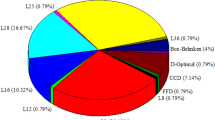Abstract
The selection of a non-traditional machining (NTM) process is often observed to be a multi-criteria decision-making problem with conflicting and diverse objectives. This paper presents a systematic methodology for selecting the best or optimal non-traditional machining process under constrained material and machining conditions. The paper also includes the design of an analytic-hierarchy-process-based expert system with a graphical user interface to ease the decision-making process. The developed expert system relies on the priority values for different criteria and sub-criteria, as related to a specific non-traditional machining process selection problem. It also depends on the logic table to discover the non-traditional machining processes that lie in the acceptability zone, and then selects the optimal process having the highest acceptability index value. The proposed expert system can automate the selection of a non-traditional machining process and provide artificial intelligence in the multi-criteria decision-making process.
Similar content being viewed by others
References
Ghosh A, Mallik AK (1985) Manufacturing science. Affiliated East West Press, New Delhi, India, pp 329 – 423
Jain VK (2002) Advanced machining processes. Allied Publishers, New Delhi, India
Pandey PC, Shan HS (1980) Modern machining processes. McGraw Hill, New Delhi, India
Saaty TL (1990) How to make a decision: the analytic hierarchy process. Eur J Oper Res 48:9–26
Saaty TL (1994) Fundamentals of decision making and priority theory with the analytic hierarchy process. RWS Publications, Pittsburgh, Pennsylvania
Vargas LG (1990) An overview of the analytic hierarchy process and its applications. Eur J Oper Res 48:2–8
Dyer JS (1990) Remarks on the analytic hierarchy process. Manage Sci 36(3):249–258
Saaty TL (2003) Decision-making with the AHP: Why is the principal eigenvector necessary. Eur J Oper Res 145:85–91
Harker PT (1997) Derivates of Perron root of a positive reciprocal matrix: with application to the analytic hierarchy process. Appl Math Comput 22:217–232
Saaty TL (1977) A scaling method for priorities in hierarchical structures. J Math Psychol 15(3):234–281
Saaty TL, Ozdemir MS (2003) Why the magic number seven plus or minus two. Math Comput Model 38:233–244
Triantaphyllou E, Mann SH (1995) Using the analytic hierarchy process for decision making in engineering applications: some challenges. Int J Ind Eng: Appl Prac 2(1):35–44
Chan FTS, Ip RWL, Lau H (2001) Integration of expert system with analytic hierarchy process for the design of material handling equipment selection system. J Mater Process Technol 116:137–145
Author information
Authors and Affiliations
Corresponding author
Rights and permissions
About this article
Cite this article
Chakraborty, S., Dey, S. Design of an analytic-hierarchy-process-based expert system for non-traditional machining process selection. Int J Adv Manuf Technol 31, 490–500 (2006). https://doi.org/10.1007/s00170-005-0216-5
Published:
Issue Date:
DOI: https://doi.org/10.1007/s00170-005-0216-5




